Andy Warhol
The Elvis Works |
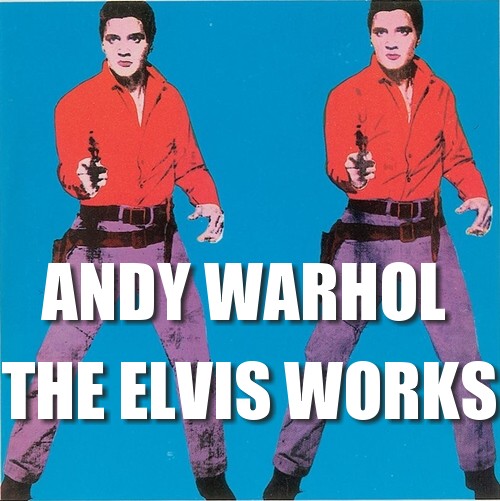 |
This article explores Andy Warhol's series of screenprinted paintings of Elvis which came in "Single", Double", "Triple" and "Pairs" image formats, as well as "Elvis (Eleven Times)"!
|
Elvis is one of a series of screenprinted paintings which Warhol made of the popular American singer Elvis Presley (1935-77).
In August 1962 Warhol began to produce paintings using the screenprinting process. He recalled that:
.. the rubber-stamp method I'd been using to repeat images suddenly seemed too homemade; I wanted something stronger that gave more of an assembly-line effect. With silkscreening you pick a photograph, blow it up, transfer it in glue onto silk, and then roll ink across it so the ink goes through the silk but not through the glue. That way you get the same image, slightly different each time. It all sounds so simple — quick and chancy. I was thrilled with it. My first experiments with screens were heads of Troy Donabue and Warren Beatty and then when Marilyn Monroe happened to die that month (August 1962), I got the idea to make screens of her beautiful face.
That same year Warhol produced a number of works repeating copies of the head of Elvis Presley.
In 1963 Warhol established a studio in an abandoned fire station in East 87th Street and hired Gerald Malanga, a young poet, to assist him with his screenprinting. It was there that he began work on a head of film star Elizabeth Taylor and a full-length portrait of Elvis Presley.
The image of Elvis was taken from a publicity still for the film Flaming Star 1960 (Twentieth Century Fox). |
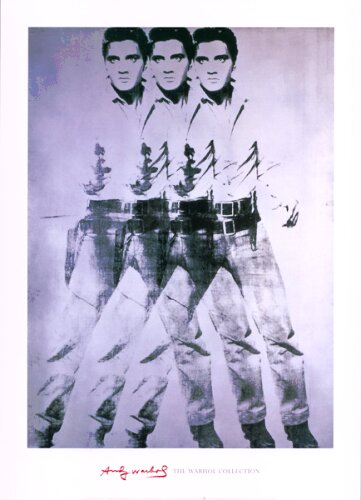 |
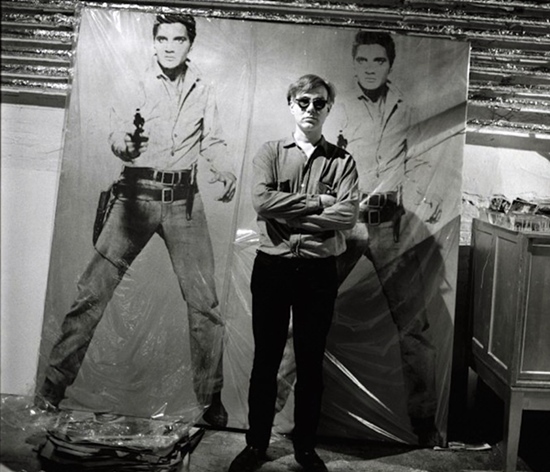 |
May 2021 - "Elvis 2 Times" sells for $37 Million: May 2021 Sotheby’s staged its auction of the American art of Texas ranching heiress Anne Marion.
Andy Warhol's "Elvis 2 Times" hit an incredible US$37 million, well above the estimate of $20 million.
The evening's sale was expected to reach $436.8 million but the final tally was $597m.
Sotheby’s Senior Vice President Michael Macaulay said: “Mrs. Marion’s extraordinary collection not only embodies critical innovations of twentieth-century American Art History, notably uniting paragons of Abstract Expressionism with original icons of Pop Art, but it also singularly reflects a simply remarkable life. Warhol’s legendary depiction of Elvis as cowboy alludes to a lifetime devoted to the stewardship of Southwestern traditions. She was a true visionary, and her collection is testament to an extraordinary eye, boundless energy and her spirit of inquiry.”
Andy Warhol, 'Elvis 2 Times' 1963 a Silkscreen ink and silver paint on linen is perhaps the most famous depiction of the King of Rock ‘n’ Roll by the Prince of Pop Art. Warhol’s 1963 'Elvis 2 Times' represents a watershed moment in twentieth-century Art History. The painting combines an investigation of the uniquely American fascination with celebrity and mass media that emerged in the 1960s with unsettling visual evocation of both violence and desire.
|
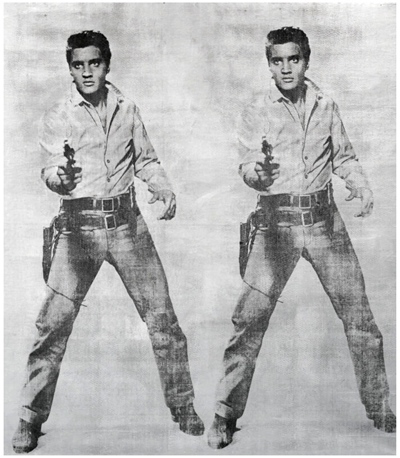 |
| For the compulsive movie-fan Andy Warhol, Elvis as the reluctant gunslinger presented the zenith of subject matter: ultimate celebrity invested with ultimate power. The source image for this particular work was a publicity still for his acclaimed 1960 movie Flaming Star, in which Elvis plays the character Pacer Burton, the son of a Texan father working as a rancher on the frontier. |
|
The new studio, according to Warhol:
...was pretty scary You literally had to hopscotch over holes in the floor And the roof leaked. But we didn't really notice all that much, we were busy getting the Elvises and the Liz Taylor silkscreens ready to ship out to California [for the exhibition at Ferus Gallery Los Angeles]. One night that summer there was a terrible thunderstorm and when I came in the next mowing, the Elvises were sopping wet — I had to do them all over again.
The image was screenprinted twenty-eight times in black paint onto a roll of silver-painted canvas in various combinations — singly, superimposed doubly and triply, and in pairs.
The whole roll of printed canvas was sent off to the Ferus Gallery with a set of stretchers, all of the same height, but of three different widths. In the absence of instructions from Warhol, Irving Blum of Ferus Gallery matched the stretchers to the images, producing five single images, six superimposed images and two diptychs of paired images — one panel of each diptych having additional colour to the screened images.
Warhol visited Los Angeles to attend the opening of his exhibition:
it was thrilling to see the Ferus Gallery with the Elvises in the front room and the Lizes in the back. Very few people on the (West) Coast knew or cared about contemporary art, and the press for my show wasn't too good. I always have to laugh, though, when I think of how Hollywood called Pop Art a put-on! Hollywood ?? I mean when you look at the kind of movies they were making then — those were supposed to be real???'
In 1963 the Elvis in the Australian National Gallery's collection was damaged on the left-hand side. According to Jan van der Marck, a former owner of the painting, 'it was attacked with a penknife by a maniac at the Castelli Gallery and subsequently restored'.
Opposite: Warhol's "Elvis" in the Australian National Gallery in Canberra.
For several years the image graced the sides of Canberra's local 'ACTION' buses as a promotion for the ANG. |
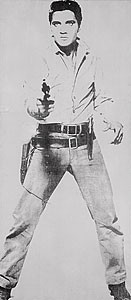 |
Sixty-five Elvis artworks, including a number of Warhol works, were exhibited as Where Is Elvis? The Man and His Reflection at the Andy Warhol Museum in mid 1973. The collection of painted and photographic works also included seminal offerings from Alfred Wertheimer, Bill Avery, Bill Ray, Ernest Withers and Roger Marshutz. One of the Warhol was "Elvis (Eleven Times)", a 1962 silkscreen variation on the artist's Elvis from Flaming Star image.
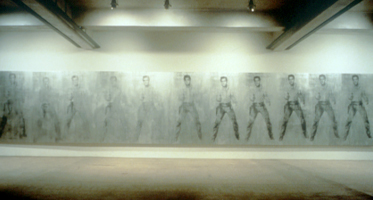
On Elvis (Eleven Times) - Many of Warhol's most famous paintings take images of celebrities from popular media as their source. Elvis is based upon a publicity still made for the 1960 film Flaming Star. Elvis in cowboy garb, pointing a gun instead of swinging a guitar, embodies two American icons: the bad-boy star and the stereotypical cowboy. The life-size image is printed numerous times on a background covered with silver paint, suggesting both the repetition of film frames and Hollywood's silver screen.
Point of View by Christiane Leach, artist and musician: "Elvis, he is the king. He is blue suede shoes and hound dog blues making those who’ve seen him eager to love him tender. He’s rag to riches, the boy next door, a sellable synthesis of black culture in white skin (like Madonna) making millions. In some communities he is considered a thief of black music and expression, but to most, ignorant of America’s musical history, he is America’s dreamboat. So as he points his gun at us, looking too sexy to shoot, one’s got to ask, is appropriation, if well executed, still a form of economic exploitation, or is it just a new life form created from the mutation of two cultures?"
Point of View by David McCarthy, Associate Professor of Art History, Rhodes College, Memphis: "It may be true that a mirror never lies, but does it necessarily tell the truth? Andy Warhol’s art is often described as a mirror of its time, and it is undeniable that his images, particularly those from the 1960s, rank among the defining documents from that decade. However, the silk screens of Elvis Presley should prompt us to reflect on their accuracy. By eliminating all vestiges of time or place, the repetitions of Elvis take him out of the past, where the cowboy myth originated, and even out of the west, where the figure resides in popular imagination, and returns it to the privacy of one individual acting out before a mirror. In this context the mirror stands as mute witness to the human capacity to invent, to make up, and to play, that is to occupy a role, even if the performance lasts for only a moment and is staged for an audience of one. Seen in this light, Warhol’s mirror may only reflect the instability of identity, and in such mutability may suggest that all the world is indeed a stage."
Point of View by Rabbi Mark N. Staitman, Rodef Shalom Congregation: "In Prayer, I speak to God. In study, God speaks to me. Judaism is a religion of text. We see Torah as a gift of God. The first century rabbi ben Bag Bag said, “Turn it and turn it, for everything of value is in it.” For 2000 years we have studied Torah, looking for Gods word to us. It is not uncommon that Torah seemingly repeats itself. Often the seeming repetition has a slight variation, but always a variation in context. While some may see this as redundancy, Judaism sees each statement as having different meaning.
God would not be redundant. The task of the student of Torah is to find the distinct meaning in each variation of the text. Though each image in the painting starts with the same picture, each can be seen to have a different meaning, each meaning to contribute to a whole; meanings and meaning which, we the viewers, the generations, discover within."
....................................................................................................................................................................................
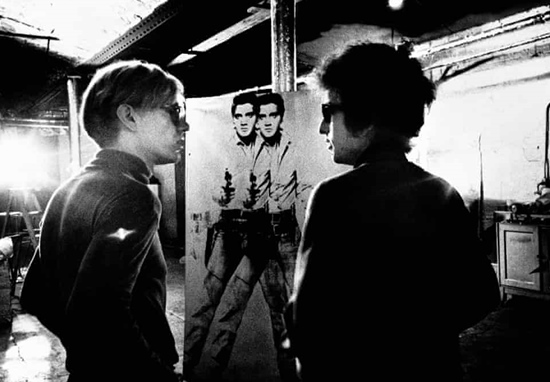 |
Bob Dylan visited Warhol in 1965 with the possibility of being in one of his movies but they didn't get along.
In an interview Warhol noted, “I liked Dylan, the way he created a brilliant new style… I even gave him one of my silver Elvis paintings in the days when he was first around. Later on, though, I got paranoid when I heard rumors that he had used the Elvis as a dart board up in the country. When I’d ask, ‘Why did he do that?’ I got the idea that people said that Dylan didn’t like me, that he blamed me for Edie’s drugs.”
Although this was Dylan’s first meeting with Warhol, it was obvious that he had taken an instant dislike to the artist, responding to Warhol’s hesitant questions in monosyllables before abruptly leaving with the 'Double Elvis' as a present.
Factory archivist Billy Name recalls Dylan putting out a “cold and unresponsive vibe”. The most likely reason behind Dylan’s attitude was because of actress Edie Sedgwick who had a rocky relationship with Warhol and the Factory gang and was a Dylan friend, something of a Dylan protégé, and was dating Dylan’s right-hand man, Bobby Neuwirth.
Leaving the Factory, Dylan and company strapped the 'Double Elvis', which already was a valuable piece of art in 1965, to the top of his station wagon and drove off.
Reports eventually floated back to Warhol that Dylan had thrown the Elvis in a closet, had hung it upside down, or was using it as dart board, all apparently designed to show his disdain for Warhol. In reality, Dylan hadn’t damaged the painting, but he had gotten rid of it.
All accounts, including from Dylan himself, have him trading the Elvis to his manager Albert Grossman for a sofa, a decision he’d come to regret. Grossman’s widow later sold the painting at auction for a reported $750,000.
Dylan confirmed, "I once traded an Andy Warhol “Elvis Presley” painting for a sofa, which was a stupid thing to do. I always wanted to tell Andy what a stupid thing I done, and if he had another painting he would give me, I’d never do it again."
Sidenote: Bob Dylan with Warhol 'Elvis': In a recent interview Bob Dylan opened up about his music and songwriting and discussed his relationships with Frank Sinatra, Elvis Presley and others in a rare and lengthy interview.
The interview included Dylan recalling Sinatra telling him, “‘You and me, pal, we got blue eyes, we’re from up there … These other bums are from down here.’”
While Dylan has always acknowledged Elvis as a hero, noting that first hearing Elvis was like "busting out of jail."
Upon Elvis' death Dylan said, "It was so sad. I had a breakdown! I broke down. One of the very few times I went over my whole life. I went over my whole childhood. I didn't talk to anyone for a week after Elvis died. If it wasn't for Elvis and Hank Williams, I couldn't be doing what I do today." |
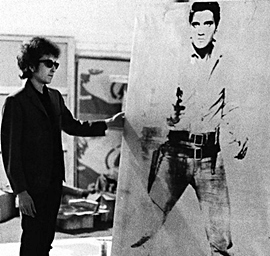 |
|
Warhol collector, Irving Blum, is quoted as saying:
"Andy sent a roll of printed Presley images, an enormous roll, and sent a box of assorted size stretched bars... I said, 'You mean, you want me to cut them? Virtually as I think they should be cut and placed around the wall?' And he said, 'Yes, cut them any way that you think should... The only thing I really want is that they should be hung edge to edge, densely - around the gallery...' And that's exactly what I did... Sometimes the images were superimposed one over the next. Sometimes they sat side-by-side. They were of varying sizes... All the same height - roughly six-and-a-half feet, as I recall. Really, life size... And I got up as many stretched up as required to fill - densely - the gallery, as per Andy's instructions. And I sent what was left on the roll back to Andy and opened the exhibit."
Many of Warhol's Elvis works were produced as synthetic polymer painted onto canvas.
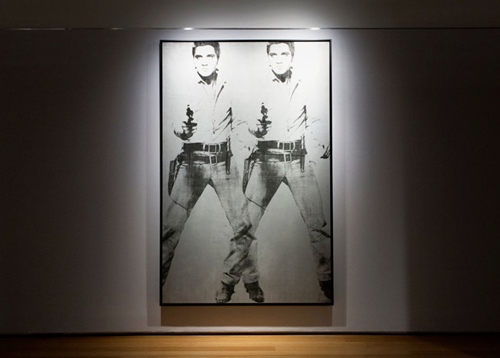 |
Christie's on 'Double Elvis' - Warhol’s mirror to Sixties America': In his paintings of Elvis Presley Warhol got to the heart of the 1960s. As Leonard Bernstein noted, "Elvis Presley is the greatest cultural force in the twentieth century."
The painting shows Elvis Presley, dressed as a gunslinger in a publicity shot for the movie Flaming Star, takes his place in a flat, empty surface that, for Warhol, functions as a looking glass that reflects the overlapping nuances of celebrity, filmmaking, desire, and performance in Sixties America.
Warhol had been fascinated by the glittering allure of Hollywood since he was a child. Double Elvis, painted in the summer of 1963, pays tribute to a larger-than-life superstar whose international fame brought him the level of celebrity Warhol so coveted and admired.
While Warhol started his key Elvis paintings in 1962, his first reference to the singer had been made earlier, in 1956, while still working as a commercial illustrator.
'Double Elvis' - when the picture was taken, Presley had recently returned from his two-year service in the US Army. His absence from America and his stream of formulaic Hollywood movies and assembly-line soundtracks meant that his status as a genuine cultural force had been neutered. Hollywood’s product-like packaging of Presley made him ripe subject matter for Warhol.
Warhol had already completed a group of initial ‘Studio Type’ Elvises but for the show at the Ferus Gallery he had something more dramatic in mind with the composition embodying the ‘silver screen’ of cinema. Displaced from any sense of narrative or locale onto pure, shining surface, they became celluloid ciphers, highlighting the artifice of Elvis’s performance — and were conceived specifically to conquer the West Coast.
There were also similarities between Warhol and Elvis, as the author John Carlin has pointed out: ‘both came from humble backgrounds and meteorically captured their respective fields in a way that seemed to break entirely with the past. Each betrayed his initial talent as soon as it became known, and opted for a blank and apparently superficial parody of earlier styles which surprisingly expanded, rather than alienated, their audience."
Sources:
- Michael Lloyd & Michael Desmond, European and American Paintings and Sculptures 1870-1970 in the Australian National Gallery (ANG), 1992 pp.326-28
- The Warhol: Diversity
- Warhol Stars
- EIN
Variations on Warhol's "Double Elvis":



Warhol of course produced many "multiple" Elvis artworks such as 'Eight Elvis' also in 1963.
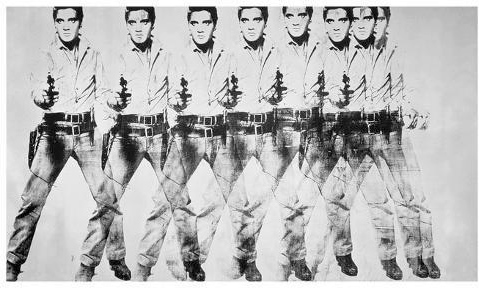
Another popular Warhol Elvis artwork is "Red Elvis":

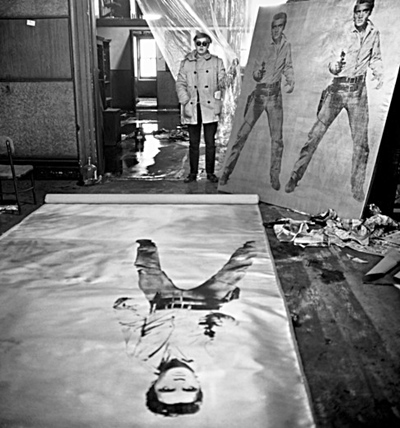
Buy Warhol Elvis prints from:
All Posters
Art.com
Comment on this article
|
|

















